Growing peppers can be easy when growing conditions are perfect. However, even your next-door neighbor can have a completely different environment that can impact their plant growth. As with anything that is alive, stressful conditions cause problems.
With peppers, your plants will give clear signals when something is wrong. One common issue we see with pepper plants is curling leaves. It can happen for several reasons, and in this article I will discuss what you can do when your pepper leaves are curling.
Video:
Why Are My Pepper Leaves Curling?
Of the many potential causes, there are 5 that are most likely to be causing pepper leaf curl. Each has a slightly different presentation of the problem, so try to diagnose your issue and treat accordingly.
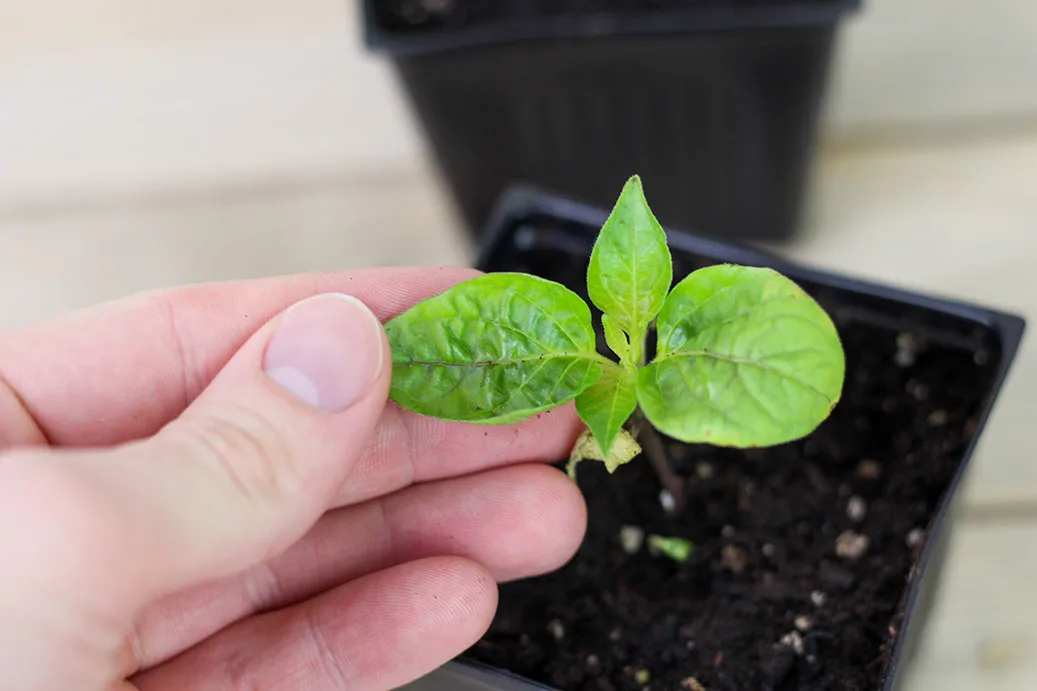
Leaves curling is a sign of stress in your plant, and it can usually be remedied with some simple adjustment to your plant care routine. Whether you’re growing in containers, indoors, or in the ground, leaf curl can impact your plants.
1. Overwatering
One of the worst things you can do to your pepper plants is to keep the soil too moist. Pepper plants prefer soil that is evenly moist, while too much water will lead to many problems.
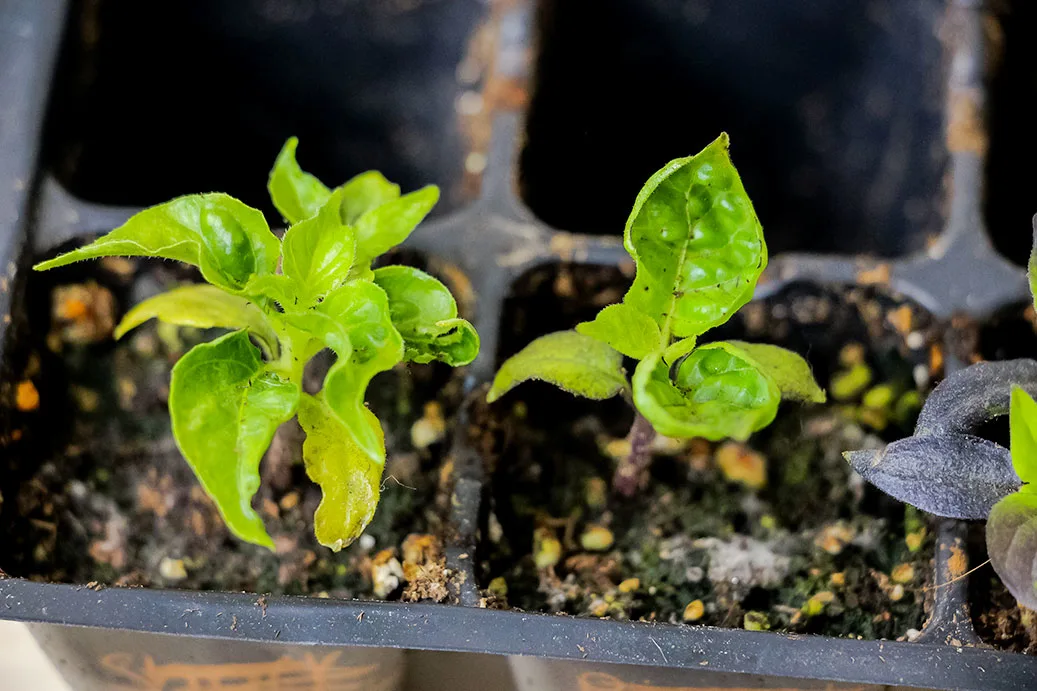
Overwatering can cause pepper leaves to curl due to the roots’ inability to access enough oxygen and nutrition from the soil. Overwatering will also usually cause yellowing leaves and stunted plant growth.
The most common reason pepper plants become overwatered is poor drainage. In pots, make sure to remove the bottom saucer to allow excess water to flow out of the drainage holes. If your pot does not have drainage holes, either drill holes in the bottom, or transplant into another container all together.
The solution: Water only when the soil is adequately dry. You can know that the soil is dry enough to water by feeling the soil 1-2″ below the surface, or by lifting the pot to feel the plant’s weight.
If you allow the plant to dry too much, the leaves will begin to wilt, but will quickly rebound after being watered. You can also try using a cheap water meter from amazon to check soil moisture levels (though the reliability is not great).
Learn more about watering pepper plants in our article here.
2. Plant Edema
Plant edema is a common cellular disorder caused by irregular water retention. It will appear in peppers as a whitish, crystallized texture underneath the leaves. Extreme edema can cause plant leaves to curl.
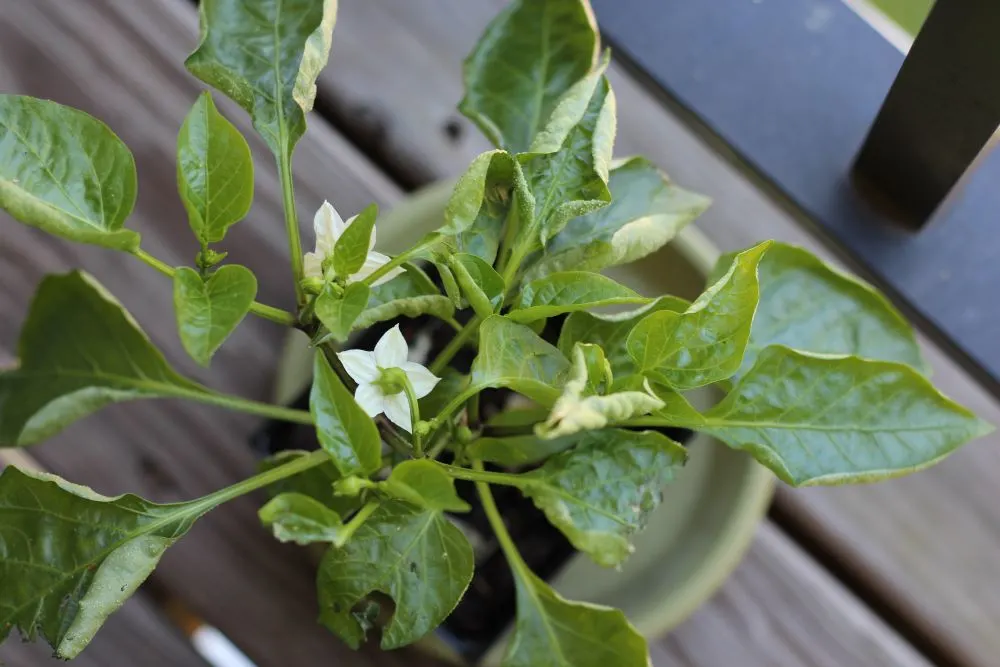
Edema is most common on indoor pepper plants, but can occur in any conditions. It is not a very well understood disorder, but in our experience, a few environmental changes can help.
The solution: Improve aeration for indoor plants by using a small fan to move the air around your plants. Also, if it the air is very dry, increase humidity with a humidifier.
Some pepper varieties are more vulnerable to plant edema than others. One plant may have a severe case, while a different variety right next to it is unaffected. It is not contagious like other diseases.
Read more about identifying and treating plant edema here.
3. Nutrient Deficiency
One possible cause for ‘bubbled’ curling is a nutrient deficiency. Calcium is a secondary nutrient for pepper plant growth. Among other things, it is used by plants to develop strong cell walls.
When plants lack calcium, leaves can not develop properly and will begin to appear curled and/or bubbly. This is sometimes accompanied by brown spots on the leaves and there may be other signs of nutrient deficiency like yellow leaves.
The solution: Test soil for pH and calcium. Soil acidity affects a plant’s ability to take up and use all the available nutrients.
Keep in mind, calcium is rarely deficient in soil, it is more often that plants are unable to access it (nutrient lockout). Testing your ground soil every 1-2 years will help you understand which nutrients are lacking and whether pH is a concern.
If your soil does lack calcium, it is available to add to soil in many formats (bone meal, etc.) Be sure to add calcium and magnesium, as adding just one nutrient can cause a deficiency in the other. These nutrients are sometimes, but not always included in all-purpose fertilizers, so check the ingredients!
Miracle-Gro Organics is a simple, well-balanced fertilizer that contains calcium and magnesium.
Many potting mixes will also include calcium, but not all. Check your soil to see what nutrients are added. If you are planting in the ground, try sending a soil sample for analysis.
4. Too Much Light
Providing light to your pepper plants is essential from day 1. Most pepper varieties like full sunlight throughout the season, so if you are planting outdoors, lighting is unlikely to be the issue.
A more common issue is caused by using indoor grow lights incorrectly. Grow lights can vary widely in brightness and intensity. They are essential if you start your own pepper seeds indoors, but you have to follow your grow light’s instructions for how close the lights should be to your plants.
See our recommended grow lights here.
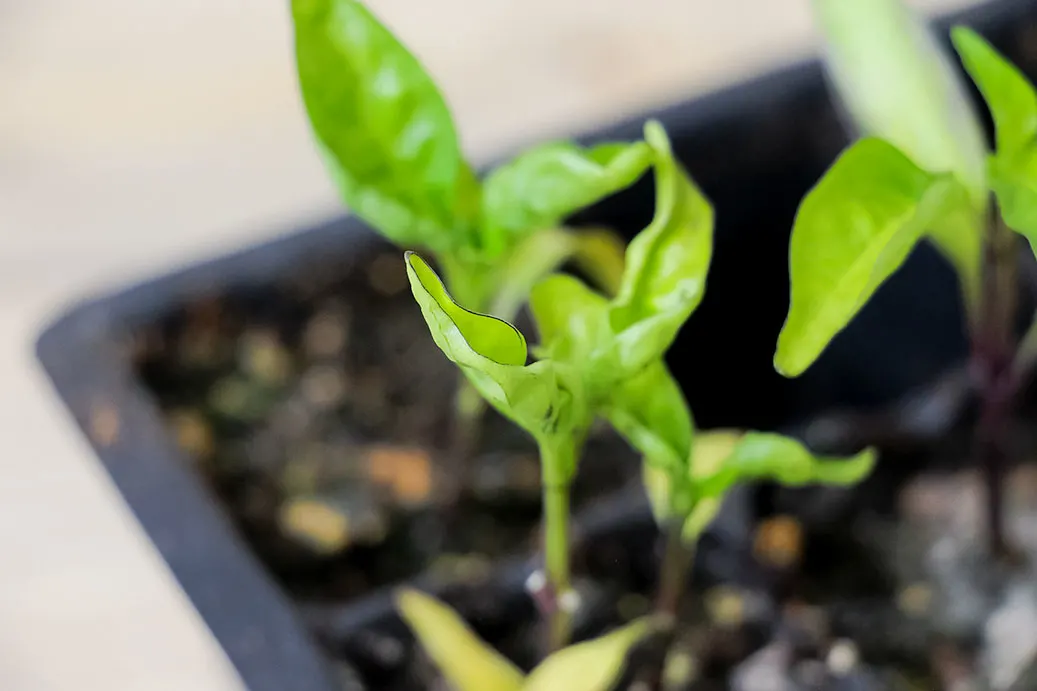
If your plants are too close to the light, you will begin to see the leaves curling up and closing in rebellion from the intense light. This problem can eventually cause pepper leaves to dry up and fall off, often turning brown and crumbling when squeezed.
Keep in mind, this issue usually affects young, tender plants more than mature peppers. Seedlings are more delicate than fully-formed plants.
The solution: If you think your plants have light burn, adjust your lights a few inches higher. Our grow light needs to be 12-18 inches away from the canopy of leaves.
Also, make sure the lights are set on a timer to be on for 12-16 hours, and off for the rest of the day. Check that the timer is working properly, as 24/7 light is not good!
If your outdoor plants have leaf curl, the issue is not likely to be lighting. One possible cause is improper hardening off. When indoor plants move outside, they must be gradually adjusted to the direct sunlight. Sudden exposure can lead to curling and sun scald.
5. Insect Damage
Unchecked insect infestations can quickly become the bane of your garden. They come from seemingly nowhere and can wreak havoc on your plants in a matter of days.
Curling pepper leaves can be a sign of a pest problem, though it will typically be focused on individual leaves rather than the whole plant. Curled and bubbled leaves could be the leaves that the insects have been feeding on.
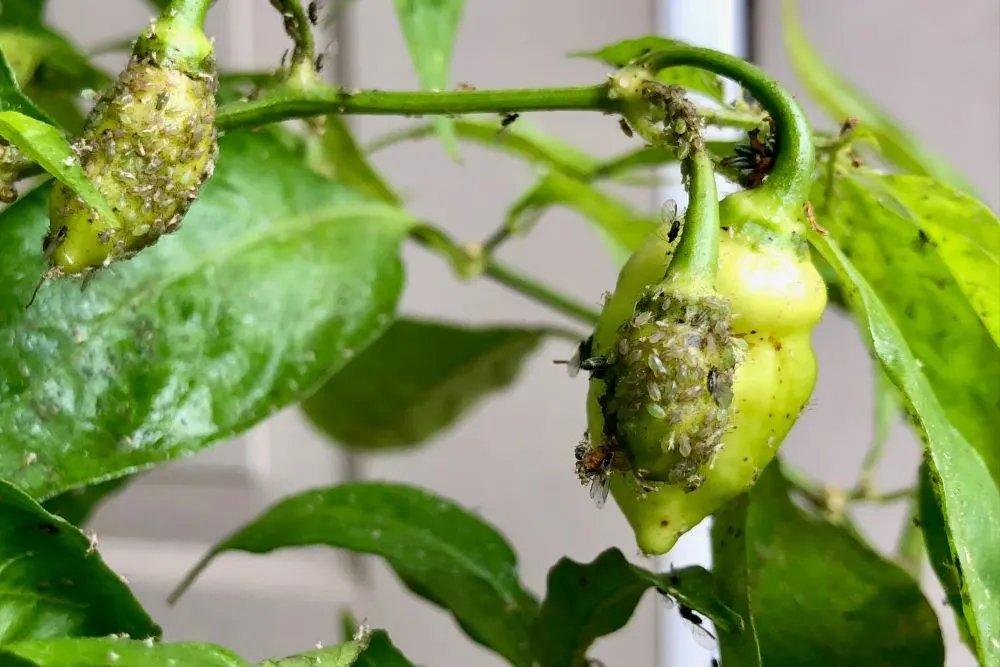
If the entire pepper plant has curled leaves, it is likely one of the other issues mentioned. However, if you notice localized leaf curling, you may have aphids, thrips, spider mites, or another pest.
Unfortunately, pest removal is more difficult than preventative care. However, you can take some measures to try to alleviate the issue and get rid of most of the insects.
The solution: Spray off aphids and other sap sucking insects with water. For extra protection, use insecticidal soap spray. Also, plant alyssum and other beneficial companion plants to attract predatory insects that eat common pests.
As a preventative measure, diluted neem oil spray can be effective – simply work the suggested amount into your soil before transplanting, or spray a diluted solution onto the foliage.
Other Causes Of Pepper Leaves Curling
Though the causes mentioned above are the most common, there are many other potential issues that can cause curling leaves. If you are sure that none of the other causes apply, or you have tried without success, there are some other, less common causes.
- Your plants could be root bound. Learn more about root bound plants in our article here. This issue is caused by plants being kept in containers that are too small. The roots become entangled, sometimes causing distorted leaves.
- Your pepper plants could have a bacterial infection, though this is often accompanied by brown, circular spots. This is often caused by using sterilized soil which can attract new colonizers, or by soil splashing on low leaves. Read more about pepper plant diseases here.
- If you are growing indoors, your plants may suffer from poor pollination, which can cause distorted leaves. Try hand pollinating or shaking the plants after the flowers have opened. This issue is also accompanied by dropped flowers and a lack of fruits.
After treatment for curled pepper leaves, do not expect the leaves to flatten out and look perfectly healthy. Just because the plant doesn’t re-form to look beautiful doesn’t mean the issue hasn’t been resolved.
Expect new leaves to look normal, while any curled leaves will remain curled, even after successful treatment. The best way to solve most planting issues is to learn from past mistakes and avoid them in the future!
Learn more about growing peppers here to give your pepper plants the best chance they have from day 1.
Remember, curling pepper plant leaves are usually nothing to worry too much about! Look at your plants as a whole and try not to get too hung up on just a few curled leaves.
If the newest foliage looks healthy, then be happy about that. Keep an eye out for more concerning issues like fungal infections and garden pests.
Read Next:
I hope this article helped you diagnose why your pepper plant leaves are curling. Growing peppers can be a challenge, but the reward is always worth the extra effort. Good luck, and let us know if you’ve had success with treating your curling pepper plant leaves!


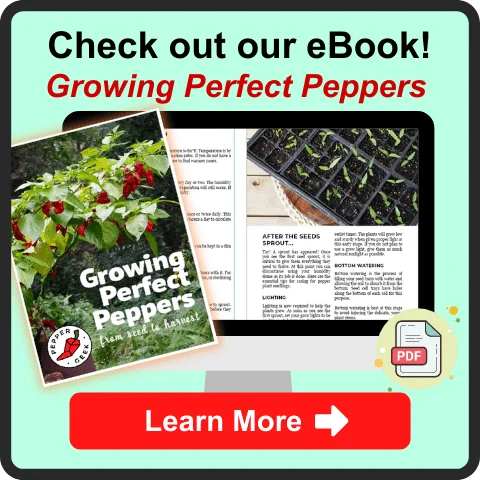

Fabiana
Friday 22nd of December 2023
Hi! Thank you for your article. I wanted to ask if the possibility of grubs could be the cause of curling leaves, too. I recently started gardening, and I found these grubs all over my planters. I read that they attack the roots. I am trying to remove them by hand and they are many.
peppergeek
Wednesday 27th of December 2023
Grubs can be a pain, and if they are beetle grubs the beetles can also cause issues with chewing the leaves. I have seen some gardeners use a soil sifter to help remove larger grubs. Birds and toads also eat them, so maybe try attracting those beneficials
Walter Anderson
Friday 8th of September 2023
Hello Calvin You articles are very informative. I have had a few issues with my peppers. One I believe is mites. So I pull them. They only go after a few types of my plants.
I have a very rare chili I brought home from he jungle in the Yucutan Mexico. A very mini very spicy ORANGE fruit. I sent some to UNM Las Cruces to the Chili Lab and they had no record in their data base of chili plants.
I would like to send you some pictures and dried fruit to check out my Yucutan find.
Also if possible to send a few pictures of infected plants.
Best regards Sincerely from Walter Anderson
peppergeek
Saturday 9th of September 2023
Hi Walter - that sounds amazing! Email me at [email protected] with any pictures you have. Would love to hear more about how you discovered the Mexican chile and where you were exactly, etc. Thanks!
jam
Monday 15th of May 2023
I removed & dried seeds from some extra large Jalapeno peppers that I bought at the local farmer's market last fall. I planted them in March & almost all germinated. The seed leaves were huge, about 2-3" long. I've never seen them that big before plus it seemed to take a long time for regular leaves to develop. The plants are doing well though, currently about 8" tall. Any idea why the seed leaves were so big?
Oghoro tega
Tuesday 2nd of May 2023
Good morning please help me my pepper leave are curling and i don't know what to do please help me with solution
Omoruwou Raymond
Sunday 30th of April 2023
The article is very educative, but my problem with my pepper farm is that the first set of flowers fell off and their leaves begin falling off.l don't know what to do.
peppergeek
Monday 1st of May 2023
It sounds like it could be disease. You want to have lots of bacterial activity in the soil, add compost and broken down organic matter to the soil to help feed the beneficial bacteria. Also, plant disease resistant varieties if possible.